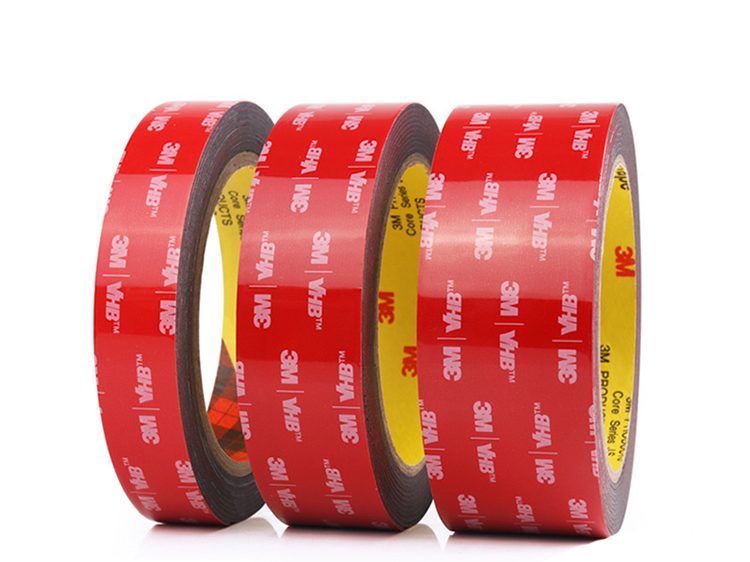
If you’re replacing screws, clips, welds, or liquid adhesives, 3M VHB is usually on your shortlist. The challenge isn’t whether VHB can do the job, it’s which construction will give you the best wet-out, the right bond-line thickness, and reliable performance under real-world stress. This guide shows you how to select a VHB tape based on substrates, environment, and assembly needs, then highlights a short list of proven SKUs VST carries that cover the vast majority of use cases.
VST supplies 3M VHB in master rolls, custom slit widths, and die-cut parts to your drawings, so once you’ve identified the right family and thickness, you can have parts arrive line-ready.
Rather than drowning you in model numbers, start with the core families that solve distinct problems:
Those families alone cover clear bonding, HSE workhorses, painted/plastic assemblies, ultra-thin electronics builds, and automotive exterior attachments.
VHB loves metals, glass, and other high-surface-energy (HSE) materials. Painted and powder-coated surfaces, ABS, PC, and other plastics often need a modified-acrylic system (e.g., 5952 family) for better wet-out. Truly low-surface-energy (LSE) plastics may require priming or a specialty LSE tape; if you’re unsure, request a quick adhesion check.
Thin, firm foams such as 4905/4910 excel on smooth, rigid parts; thicker foams like 5962 (in the 5952 family) add gap-filling, sealing, and vibration damping. Product data sheets list nominal thicknesses so you can build stack-ups correctly.
Consider heat, UV, solvents, moisture, and any flame/smoke requirements. If you need flame retardancy, 5958FR offers the 5952 family’s broad adhesion with an FR rating. For automotive exterior trim, 5608 provides weather resistance and is designed for painted panels.
Check minimum application temperatures and allow for dwell (bond builds over 72 hours at room temperature in many VHB systems). Use firm pressure and proper surface prep. If you must install in cold conditions, a cold-apply variant such as 4951 can help. Always verify in the product TDS before writing your work instruction.
For glass-to-metal, glass-to-glass, or back-painted acrylic where the joint must disappear, these clear VHBs are the go-to. 4905 is ~0.5 mm; 4910 is ~1.0 mm for a little more forgiveness. Both use general-purpose acrylic adhesive on a firm foam core, ideal for rigid, smooth parts (signage, architectural trims, clear covers).
Choose if: you need an invisible joint and your surfaces are HSE and smooth.
Avoid if: you’re bonding powder coat or LSE plastics. Use a 5952-family tape instead.
The white 4950 is the classic firm-foam VHB for metals, glass, and other HSE materials. It’s widely used to replace rivets and screws on rigid panels, brackets, and frames. If your production area is cold or you install outdoors, 4951 retains better tack at low application temperatures.
Choose if: you’re on metals/HSE paints and want a firm feel and high shear.
Avoid if: your topcoat is powder-coated or you’re on trickier plastics. Go 5952 family.
The 5952 family uses a modified-acrylic adhesive and a very conformable foam to wet-out paints and many medium/low-surface-energy plastics better than the firm white VHBs. Thicknesses scale from 5925 (~0.6 mm) to 5952 (~1.1 mm) to 5962 (~1.6 mm) so you can pick the bond-line that matches your gap and sealing needs. These are staples for frames, powder-coated enclosures, and mixed-material brackets.
Choose if: you’re bonding painted metals, powder coat, or mixed plastics and need forgiving conformability.
Bonus option: 5958FR (1.0 mm) adds flame retardancy while keeping 5952-style bonding behavior.
When you need narrow bond lines, precision die-cuts, and drop-test performance in devices, look to 5980 (0.15–0.30 mm) and 5981 (0.20–0.40 mm). These constructions combine thin foams with high-performance modified acrylic adhesive; 5981 adds a thin carrier for better handling and rework. Typical uses include cover-lens frames, camera modules, antennas, and display stacks.
Choose if: you’re building compact electronics that must pass impact tests with minimal step height.
Designed for automotive paints and body contours, 5608 provides weather and UV resistance with a conformable foam core. It’s used for elastomeric weatherstrip, exterior trims, and badges. If your part must live on a car’s exterior, start here before migrating to a specialty GT/RT acrylic-foam if needed.
| Use Case | Recommended VHB | Why it Fits |
|---|---|---|
| Invisible glass/acrylic bonds on HSE | 4905 (0.5 mm), 4910 (1.0 mm) | Clear, firm foam for smooth, rigid parts |
| Metals & HSE paints (general purpose) | 4950; cold-apply 4951 | Firm, high-shear workhorses that replace fasteners |
| Powder coat, painted plastics, mixed materials | 5925/5952/5962 | Modified-acrylic, very conformable; better wet-out on paints/plastics |
| Flame-retardant requirement (e.g., enclosures, transport interiors) | 5958FR (1.0 mm) | FR version of the 5952-style chemistry |
| Ultra-thin electronics assemblies | 5980 (0.15–0.30 mm), 5981 (0.20–0.40 mm) | Thin foams for narrow bond lines and drop-test performance |
| Automotive trims & weatherstrip | 5608 | Built for painted exteriors, weather/UV exposure |
Selecting the right 3M VHB tape comes down to matching your substrates, choosing an appropriate bond-line thickness, and accounting for the environment your assembly will face. Start with a clear view of your materials and finish types, then narrow in on the family that best wets out those surfaces and delivers the durability you need. With a short trial on your actual parts, you can confirm peel, shear, and long-term performance before scaling to production.
Once you’ve identified the right construction, consistent surface prep and correct application pressure will do the rest. VHB is designed to replace mechanical fasteners in many builds, improving aesthetics and distributing stress more evenly across the joint, often with faster takt times and cleaner lines. Ready to source? Check out our 3M VHB tapes today!